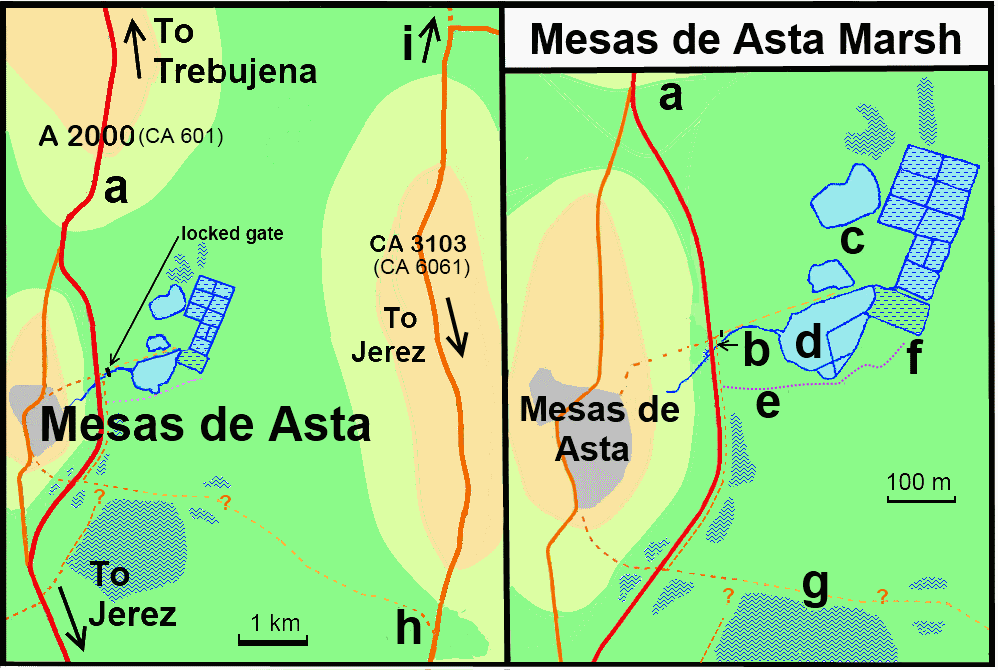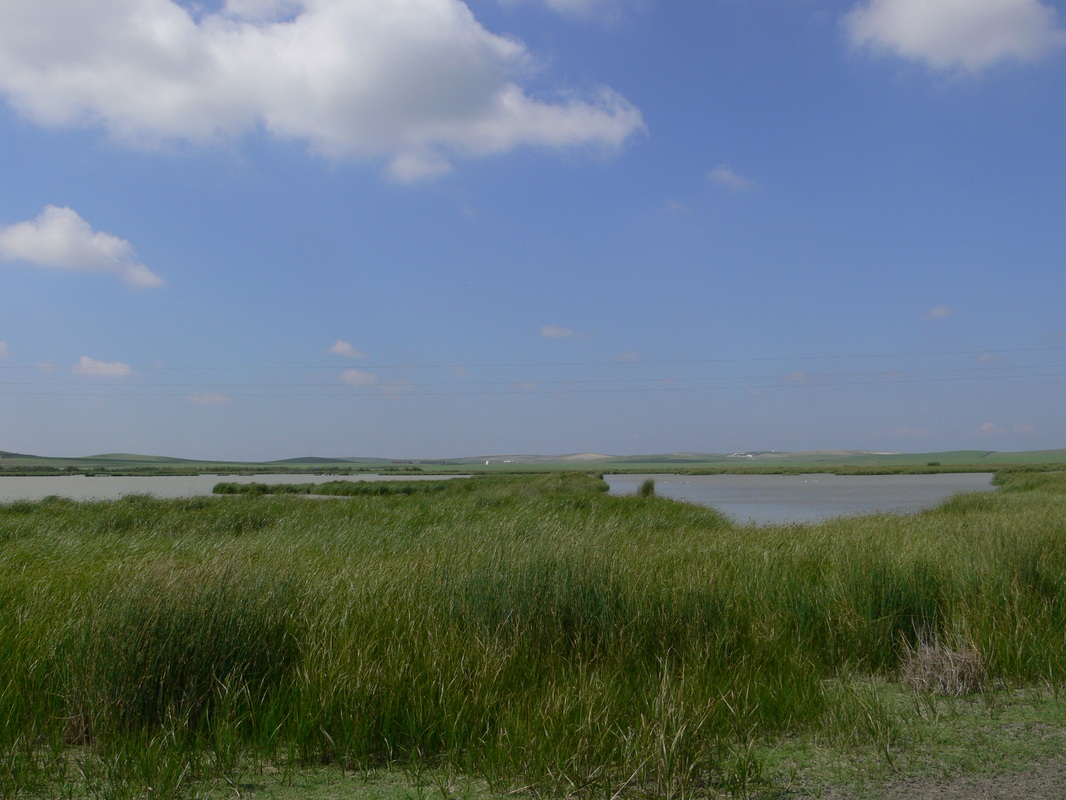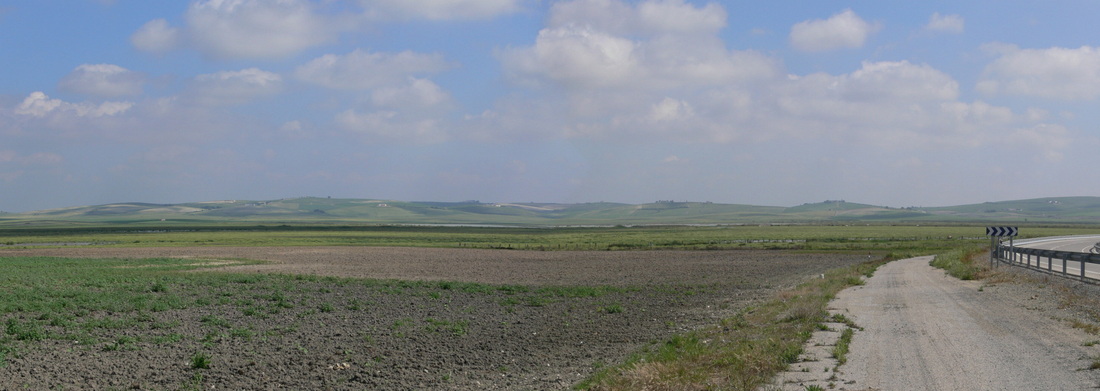Mesas de Asta, c8km north of Jerez, is a somewhat ‘down-at-heel’ place with scruffy little houses suggestive of a poor agricultural village in a state of decline. Yet this air of decrepitude hides the illustrious history of the pueblo. A settlement here was established in Neolithic times (c5,000 BC). Mentioned by both Livy and Pliny the Elder, it became an important trading centre of for the mysterious Tartessian civilization of the Late Bronze Age. At this time the settlement, perched on a small island surrounded by the waters of the Guadaliquivir estuary (called Ligustino lake), traded with the Phoenicians and Greeks. This prosperity continued under the Romans when it was known as Asta Regia. Unfortunately, little of this now remains above ground as the city was abandoned in the 11th century in favour of nearby Jerez and, as so often, the ruins quarried for good building stone. It was only in the 1940s that it was resettled by local “campesinos”. At around the same time the ruins were excavated and many items can be seen in the archaeological museum in Jerez. Recent population figures show that the population has slipped from over 600 in the 1990s down to just under 500 today. It remains to be seen whether the new bypass round the village will hasten the village’s decline or encourage an influx of commuters from Jerez.
When I first came this way a few years ago the main road (A 2000) between Trebujena and Jerez still ran through the village. As a result, since it was pretty much hidden from the road, I was quite unaware that to the east there was an excellent small marsh. It was when I came this way one spring a few years later, en route to Jerez from Trebujena, that took the new bypass and I discovered the site. The first clue came a couple of kilometres towards Trebujena (a) when a flock of Gull-billed Terns dipped and weaved across the road. As I drove south along the new road I had glimpses of shimmering water off to the my left and then still more terns. Fortunately, scarcely more than 1.5km south of the northern exit for Mesas de Asta, I was able to pull off on a track (b) to my left. (For those arriving from Jerez, this point is just over 2.5 km north of the southern exit for Mesas de Asta). From here I could see distant shallow lagunas or flooded fields and what I took to be salinas (c) – I later found they were actually settling beds for the sugar refining industry (see later). These were crowded with Flamingos, Black-winged Stilt and numerous smaller waders, but, disappointingly, the track out to them was securely padlocked. Fortunately, a small laguna (d) was much closer to hand and here there were Lapwing, Black-tailed Godwit, Green Sandpiper and more small waders. Hawking over the fields were still more Gull-billed Terns – a quick scan suggested 500+ birds – plus dozens of Collared Pratincole. I’ve also had Stone Curlew nearby and the hills beyond were once home to Little Bustard (which may yet persist). From the reeds the loud grouchy tones of Great-reed Warbler could be heard even at this distance. Drifting low over the fields were at least 5 Montagu’s Harrier, a handful of Lesser Kestrel plus a host of hirundines. In the culvert closer to hand a pair of Red-rumped Swallows was busily building a nest. In short it was a great place to pull over and watch a few birds although the experience was greatly enhanced by a good ‘scope to check the more distant birds.
Since it was late in the day on that second visit I had little time to explore more thoroughly, but the following autumn I had another look, but this time I’d been tipped off that there was a narrow track (e) running out towards the small laguna (d) along the line of some small electricity pylons. Many of the same birds were seen, but the terns and pratincoles came over at even closer range and I managed to add Tawny Pipit to the list. This track then peters out just short of the settling ponds (f). According to a new leaflet about birding around Jerez (see p23 http://www.turismojerez.com/fileadmin/images/ruta_natural/guiarutanatural_.pdf ) these pans are strictly private as the firmly padlocked gate suggests. This though, is not quite the end of the story. Some research about the area back in the UK uncovered the following nugget of information culled from online documentation posted in 2010 by the owners (Ebro Foods) of the now apparently defunct sugar refinery:-
In its endeavour to guarantee the conservation and protection of biodiversity, Ebro Foods set up an ambitious programme, jointly with the Environmental Authority in Cadiz, for regeneration of the land of the settling ponds of the former Guadalcacín sugar factory, consisting of creating a vast wetland for the preservation of bird fauna in the area of the Mesas de Asta marsh.
If this proves to be more than empty promises then this could be an area well worth keeping an eye on (attempts to contact the company to ask about this have not proven successful).
Whatever the prospects for future ecological development, there remains much more to discover here. The fields beside the new road (esp. to the east) are often flooded and safely viewable from the small track running beside the main road (unless the fords here are too deep). Further south still an old track – Canada Real Ancha (g) – runs from the outskirts of Mesas de Asta village, under the new road and out across the salty steppe-like fields. Certainly impassable when wet and probably so when dry, in theory this ancient drovers’ road should continue on to the CA 3103 (h). This is an area I’ve not yet explored, but when wet it attracts large numbers of waders, pratincoles and terns and when dry can hold Stone Curlew. Pin-tailed Sandgrouse must be a good long shot in this area when conditions aresuitable. However, if this species is a target then‘Cassablanca Marshes’ (i) north off the CA 3103 is a better bet.
Access: The A2000, as it is called on signposts and Googlemaps (although older maps may call it the CA 601) runs due south from Trebujena towards Jerez. From the south take Exit 637 off the A4 (Avenida del Sur) as it passes north of Jerez and onto the A2000 (signposted Trebujena). Access on foot along the track to (d) seems to be tolerated (others have driven along it in a 4x4 although I’m uncertain how welcome this might be). As the settling beds are private, it is unwise to go much further without permission. In theory, the Canada Real Ancha should be open to all – be aware that, to judge from footage on Youtube, this area is sometimes frequented by youths on trail bikes.




 RSS Feed
RSS Feed
